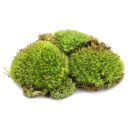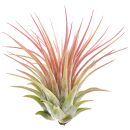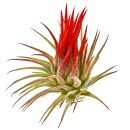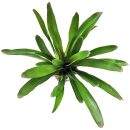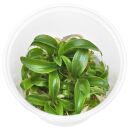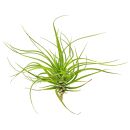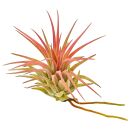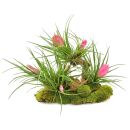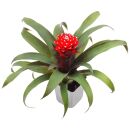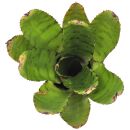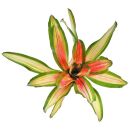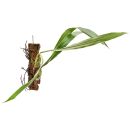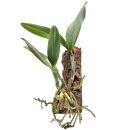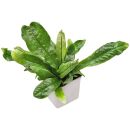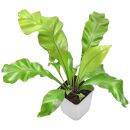- Natural terrarium decoration
- Durable moss cushions
- Freshly green when moist, silvery white when dry
- Small Tillandsia from Guatemala
- About 5 - 8 cm high
- Pink-red leaves during bloom
- Small Grey Tillandsia from Mesoamerica
- About 5 - 8 cm high
- Contrasting colours during bloom
- Bright red leaf rosettes
- Prefers bright, indirect light
- Ideal for high humidity
- Colour accent in terrarium landscapes
- Stores water in leaf rosette
- Also called Philodendron "Mini"
- Small climbing aroid
- Lanceolate leaves
- Rather slow growth
- Suitable for rainforest terrariums
- Rosette-shaped Tillandsia
- Reaches up to 60 cm in growth
- Very robust, long flowering time
- Suitable for rainforest terrariums
- Fine-leaved Tillandsia
- Upright, thin rosette leaves
- Delicate pink flower
- Suitable for rainforest terrariums
- Epiphyte from cloud forests in Guatemala and El Salvador
- Regularly formed leaf rosette
- Suitable for rainforest terrariums
- Small Tillandsia from Central America
- About 5 - 8 cm high
- Peachy-red leaves during bloom
- Elegant leaf rosettes
- Magnificent inflorescence
- Suitable for rainforest terrariums
- Small funnel bromeliad
- Turns purple with enough light
- Graceful leaves
- Very attractive
- Suitable for small rainforest terrariums
- Medium sized funnel bromeliad
- Green leaves fading into indigo
- Tongue-shaped lanceolate leaves
- Small flowers deep in the funnel
- Suitable for rainforest terrariums
- Heart-shaped, velvety leaves
- Leaves grow up to 30 cm
- Can be used as an epiphyte
- Thrives in bright, indirect light
- Perfect for tropical setups
- Tank bromeliad
- Up to 80 cm wide
- Glossy dark green leaves
- Bright red inflorescence
- Epiphyte for tropical terrariums
- Originates from South America
- Bromeliad family
- Epiphytic growth
- Lance-shaped, striped leaves
- Thrives at 18 - 27 °C
- Originates from South America
- Bromeliad family
- Epiphytic growth
- Tricoloured leaves (green, white, pink)
- Thrives at 18 - 28 °C
- Originates from South America
- Bromeliad family
- Epiphytic growth
- Green leaves with white/cream stripes
- Thrives at 18 - 28 °C
- Originates from South America
- Bromeliad family
- Epiphytic growth
- Green leaves with red spots
- Thrives at 18 - 28 °C
- Endemic to Brazil
- Bromeliad family
- Epiphytic growth
- Green leaves, reddish tips
- Thrives at 18 - 28 °C
- Orchid with Himalayan origin
- Hanging flower clusters
- White, fragrant flowers
- Prefers cool temperatures
- Humidity loving
- Also known as Coelogyne ochracea
- Fragrant white flowers
- Moisture-loving
- Shady location
- Spring bloomer
- Mixture of magnificently flowering cultivars
- 30 - 50 cm growth height
- Large, fragrant, multicolored flowers
- Epiphytic orchid for larger tropical terrariums
- Also suitable for pots with orchid substrate
- Large epiphytic fern from tropical Asia
- Reptile skin-like leaf structure
- Rosette-like growth habit
- Recommended for large rainforest terrariums
- Also suitable as a ground plant
- Indirect light or partial shade
- Prefers high humidity
- Moderate watering required
- Can be cultivated epiphytically and terraristically
Terrarium plants - Epiphytes - Green up your terrarium!
These plants grow on other plants. Algae on aquatic plants are also epiphytes, but here we are talking about those that grow on trees and shrubs. Unlike parasites, they do not tap into the pathways of the host plant to supply themselves with water and nutrients. They are merely sitters that can access more light in this way than on the forest floor. In northern latitudes it is mainly mosses, lichens and algae on the bark of trunks and branches, in the warmer regions of the world there are countless "higher" plant species. There are particularly many epiphytes among the orchids and ferns, and Central and South America is known for its countless epiphytic bromeliads. Even cacti, otherwise inhabitants of dry areas, colonise humid tropical forests there as epiphytes, including rod cactus (Rhipsalis) and Christmas cactus (Schlumbergera). Epiphytes are most common in rainy and foggy areas, but various Tillandsia species can also be found in dry forests and even semi-deserts.
In cultivation, many epiphytes need a loose substrate in which to root. The "atmospheric" epiphytes, on the other hand, only need to be attached to a base because they absorb water and nutrients via their leaves or aerial roots. Epiphytes from rainforests usually need high humidity and frequent humidification. In contrast, the so-called grey tillandsias in particular must not be kept too moist. They should be allowed to dry out after spraying and need air movement.


